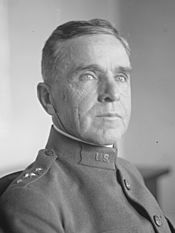Robert Lee Bullard facts for kids
Quick facts for kids
Robert L. Bullard
|
|
|---|---|

General Robert L. Bullard, 2nd Army Corps, Toul, 1918
|
|
| Born | January 5, 1861 Lee County, Alabama, United States |
| Died | September 11, 1947 (aged 86) New York City, United States |
| Buried |
West Point Cemetery
|
| Allegiance | |
| Service/ |
|
| Years of service | 1885–1925 |
| Rank | |
| Unit | |
| Commands held | 26th Infantry Regiment 1st Infantry Division III Corps Second Army |
| Battles/wars | Spanish–American War Philippine–American War Mexican Border Service World War I |
| Awards | Distinguished Service Medal |
| Other work | President of National Security League author orator |
Robert Lee Bullard (born January 5, 1861 – died September 11, 1947) was a very important officer in the United States Army. He was part of many conflicts, including those in the American Western Frontier and the Philippines. He is best known for his role in World War I. During that war, he led the 1st Infantry Division, also known as "The Big Red One." He commanded them during the Battle of Cantigny on the Western Front. After his military career, he also worked as an administrator in Cuba.
Contents
Who Was Robert Bullard?
Robert Bullard was born in Alabama. He went to college at what is now Auburn University. Then, he attended the United States Military Academy, which is a famous school for army officers. He graduated in 1885.
After graduating, Bullard served in several important roles. He was involved in the Spanish–American War. He also served in the Philippines from 1902 to 1904. In 1907, he worked as a special investigator for the U.S. government in Cuba. The next year, he was in charge of public education there.
Bullard's Role in World War I
When the United States joined World War I, Bullard quickly rose through the ranks. He became a brigadier general in June 1917. Soon after, in August 1917, he became a major general. From December 1917 to July 1918, he was the commander of the 1st Infantry Division, known as the "Big Red One."
The Battle of Cantigny
During World War I, General Bullard led his troops in the Battle of Cantigny in 1918. They successfully captured the village of Cantigny. This village was a strong German observation point. The battle was the first major attack by American forces in the war. It was seen as a success because it helped the American front line move forward.
General John J. Pershing, a top American commander, praised the attack. He said that the Germans fought back very hard. They tried to take Cantigny back for three days. But the American soldiers held their ground.
Bullard was good at speaking French. This helped him work well with French and American forces during the war.
Leading the Second U.S. Army
In October 1918, General Pershing created the Second U.S. Army. He chose Bullard to be its first commander. Bullard was given the rank of lieutenant general. At the same time, Pershing put Lieutenant General Hunter Liggett in charge of the First United States Army. Pershing remained the overall commander of all American forces in Europe.
Some of Bullard's actions during the war were criticized. For example, during the Battle of Montfaucon, some people said he didn't follow orders. They claimed he didn't help another division attack the German fortress at Montfaucon. This might have caused more American soldiers to get hurt. Also, Bullard continued fighting even when he knew the war was about to end. This was also criticized by some.
After the War

The Second Army was closed down in April 1919. Bullard then went back to his permanent rank of major general. He retired from the army in 1925. After retiring, he focused on writing books. He also became the last president of the National Security League. He led this group from 1925 until it was closed in 1947.
Bullard wrote a book called American Soldiers Also Fought in 1936. He passed away on September 11, 1947. He is buried at the U.S. Military Academy Post Cemetery with his wife, Ella.
Books by Robert Bullard
Robert Bullard wrote these books:
- Personalities and Reminiscences of the War, New York: Doubleday Page, 1925. ISBN: 0-7661-9742-5
- American Soldiers also Fought, New York: Longmans, Green and Co., 1936.
He also wrote articles for different magazines.
Awards and Honors
General Bullard received many awards for his service:
- Distinguished Service Medal
- Indian Campaign Medal
- Spanish War Service Medal
- Philippine Campaign Medal
- Army of Cuban Pacification Medal
- Mexican Border Service Medal
- Victory Medal
- Commander, French Legion of Honor
- Commander, Belgian Order of Leopold
- Commander, Italian Order of Saints Maurice and Lazarus
- French Croix de Guerre with 2 palms
Images for kids


